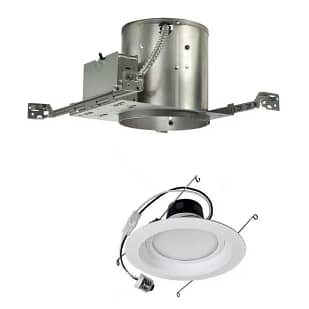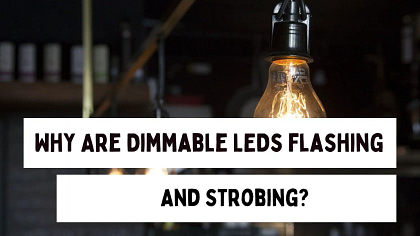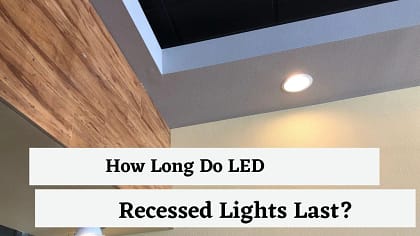Let’s debate; Cans or Canless recessed lighting which is the best?
Recessed lighting creates the overall lighting in a room and comprises fixtures that sit flush with your ceiling. They can point in whichever direction you want and provide the perfect job of remaining sleek and hidden. Choose from moveable gimbal reflectors for highlighting artwork or cabinetry. The sky is the limit with recessed lighting.
However, like many fixtures, manufacturers have modernized them to cater to a variety of needs, with canless recessed lighting being one of them. Choosing between cans or canless is difficult, especially for homeowners who do not know the difference.
Note: There are no canless vs recessed lighting because can lights are recessed lights.
Therefore, this post will compare both fixtures and highlight their advantages and disadvantages.
Can and canless do the same job of providing ambient lighting. However, canless lacks the metal housing that protects the bulbs and sometimes has an electric box. Whereas canless has a thin housing and connects directly to your electric box, they are lightweight and do not give you customizable trimming or access to any bulb.
Thus, if the canless fixture no longer works, you will have to change the entire unit.
What Is Can Lights?

Canisters comprise bar hangers that brace the fixture between the ceiling and produce a wide beam of lights. Similarly, this fixture gets its name from the housing “cans” or “canister” because of the shape.
What’s Inside Can Lights?
- The junction box has circuit wires to ensure the lights are functional.
- The wire cable attaches to the circuit wires, the metal housing containing the socket, thermal sensors, and other parts.
- Reflector–A white inner lining that helps direct the light in whatever direction you want.
- The thermal sensor is in the metal house. Its task is the sense the temperature and shuts it off whenever the fixture gets too hot. These days, nearly all can lights have this feature.
- The socket- This is where you screw in the bulb that generates the light. You can have LEDs, halogen, or compact fluorescent bulbs. Most people opt for LEDs because they produce less heat and last longer than traditional bulbs.
- Rim is attached to the reflector with the use of clips and is decorative and customizable.
How Much Does It Cost To Get Recessed Lighting?
Recessed canisters can cost anywhere from $5 to $30, with multipacks also available. Of course, LEDs are a bit more expensive, but they are cheaper to have in the long run. There are many benefits to buying LEDs besides the less heat they produce. With LEDs, there is a massive reduction in your electric bill. Plus, they last up to 50,000 hours.
Installing recessed lighting means there is little to no maintenance. But sometimes minor problems can occur like loose wires, wear-out sockets, or the thermal sensors going bad. The fixes are self-explanatory, and these fixtures can last decades before there’s a need for maintenance.
According to Fixr.com, the minimal cost is $560-$3000 to install recessed lighting. However, canless can be cheaper, especially if you are DIYing the project.
What Is Canless Recessed Lighting?

Canless recessed lights do not have metal housing. Instead, they are flat with a simple unit connecting directly to your electrical box. They a faster to install and sit flush in your ceiling.
The Difference Between Can And Canless Recessed Lighting
Canisters consist of a metal housing that holds the light bulbs in place. Their diameter ranges from 3 to 6 inches, and the wires are not visible to the naked eye. These “can” shape box protects the bulbs and provide a place for electrical cables rather than having them exposed as canless fixture do.
With cans, you can change your lightbulbs or upgrade to smart lighting with ease. Compared to Canless, where there are no physical bulbs. So if the fixture no longer works, then you will need to install a new unit.
Installing canisters means that there is more freedom to customize your light with a variety of trims. Unlike canless when the lights no longer work, you may have a hard time finding the exact match, especially if they are no longer manufactured. So bulk up on extras!
Changing Can bulbs can be tricky because of the tight space between the bulb and the trim. Even so, there is a light bulb changer with suction cups that give you a hands-free grip on the bulb for easy removal.
Can lights require an opening in the ceiling and are taller than canless lights. Therefore, they can not fit in very shallow spaces like drop ceilings. Canless is far easier to install so, many DIYs enthusiastic or people who can not afford an electrician will opt for these fixtures.
Canless lights are more energy-efficient because they do not require a huge hole in your insulation, saving a lot on your energy bill.
The Best Size Fixture For Recessed Lighting
Recessed lights are the most common type of lighting in any home, so it only makes sense that you would want to know what size recessed light to use.
These fixtures are available in many sizes and shapes, but the most common size is the 4-inch recessed light. You can use this size for most residential applications, including kitchens and bathrooms. They are also commonly used in hallways, bedrooms, living rooms, and dining rooms.
The 4-inch recessed light is a popular choice because it provides plenty of illumination for most spaces without taking up too much room. Plus, it’s easy to install and relatively inexpensive compared to other options.
How To Update Recessed Lighting?
When updating old Can recessed lighting, you can change the housing or bulb. Most people opt for bulbs like Philips Hue with dimming features, color changes, voice commands, and app control.
The Prettyhandygirl believes that updating her old can recessed lighting means converting them to canless, but this is a personal choice.
Another way is to change the trimming to a more decorative option. Again, you’ll need to upgrade all the recessed lighting trims in that room so they can look the same.
Can Recessed Lighting Cause A Fire?
Recessed lights are safe. However, if it is not installed properly, it can pose a fire hazard. Here are some tips to help you avoid installing recessed lights incorrectly:
- Use only UL-rated insulated electrical boxes made for recessed lighting.
- Install insulation around all sides of every box.
- Ensure all wires are secured tightly with wire nuts on both ends.
- Make sure no gaps between wall studs and electrical boxes.
How Many Recessed Lights On A Circuit?
How many recessed lights a single circuit can take depends on your breaker rating and bulb. Thus, a traditional 60-watt bulb with a 15amp breaker can handle 30 lights. With LEDs and CFL, the same breaker can manage 180 or more fixtures.
Do Canless Recessed Lights Get Hot?
The short answer is Yes, canless recessed light can get hot. However, not at a high temperature.
Canless recessed lights can get hot, but they dissipate the heat out of the housing. This design is much safer than traditional recessed lights.
Traditional recessed lights trap the heat around the bulb in a can which can start a fire if there are any flammable materials near the light.
Can Your Recessed Lights Die?
The answer is yes, but not as often as you might think. It’s best to prepare for the worst-case scenario with recessed lights.
Here are some of the most common causes of recessed lights dying:
Poor installation. If you install recessed lighting incorrectly, it could cause them to overheat or burn out prematurely.
Excessive heat/humidity/dust accumulation. High temperatures and humidity levels can also shorten the lifespan of recessed lights. Dust accumulation inside their housings also reduces their efficiency significantly. Thus, clean them regularly for optimal performance.
Ballast failure can cause the fixture to die. The Ballast regulates the voltage of the fixture. So if it does not work, it will burn out.
Tips When Choosing Recessed Lighting
Recessed LED lights can make a huge difference in your home, but if you’re not paying attention to color temperature when you buy them, you might be disappointed by the results.
When you’re shopping for LED recessed lighting, check the packaging. It will tell you the color temperature of the bulb. For instance, the 3000-kelvin range provides a yellowish light. It is best for bedrooms and living rooms.
While LEDs in the 4-5k kelvin range produce a bright, white light that will make colors pop and bring more clarity to areas such as bathrooms or kitchens.
Similarly, too yellow or blueish lights can interact with the color of your walls. So pay attention to your room’s color.
Dimmable Can Lights
By design, recessed lights work best when paired with a dimmer switch. Many people dislike the harsh brightness of cans. Thus, dimmer switches allow you to adjust the brightness of lights in your home.
But due to their low power consumption, LEDs don’t always work well with typical dimmer switches.
So, ensure they are compatible by researching the manufacturer’s recommendations for your bulb and dimmer switch.
Spacing
Multiple can light are strongly recommended when creating an even glow that illuminates every corner of your living space. That’s because one light alone rarely has enough power to do the job.
When creating a recessed light array, keep lights at least four feet apart on a single line.
Furthermore, even with larger six-inch lights, the overlapping cones of illumination may fail to reach effectively beyond two feet.
The minimum spacing of this distance between walls and recessed lights is recommended.
Going farther away from a surface than this distance produces shadows that are too harsh, resulting in poor illumination of the room.
My Thoughts
Overall, I prefer the traditional can lights because they allow you to adjust their appearance without altering any wires. It’s far cheaper to do this because trims are affordable. Compared to canless, where you’ll need to replace the entire unit.
Canisters allow people like me who hate messing with electrical wires to change out bulbs as you would do with a lamp. Nevertheless, there are times when you need both can and canless in your home. For instance, in places where you don’t need many fixtures like a bathroom, waterproof canless make sense.
So cans vs canless. Which fixture are you choosing? I would like to hear your thoughts in the comments.





